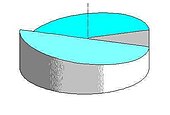Marker


The cross- sectional image indicator , together with the microprism ring, is an aid for manual focusing (focusing) on cameras .
Purpose and implementation
The split image indicator is located in the center of the focusing screen in the viewfinder ; it consists of a two-part circle, the halves of which are inclined in opposite directions (measuring wedges) and thus, when defocused, depict one part of the subject offset from the other part. If the focus is correct, the cross-sectional images fit together perfectly.
This can be assessed or the focusing works best when the subject has contour edges across the cutting line. Therefore, the cutting line is often diagonally in the viewfinder, so that vertical and horizontal lines or edges can be focused equally. Many Praktica and a Rollei mirror reflex housing also use a diagonal “double-cut image indicator” with three segments, which is called a triple measuring wedge. Occasionally there is also a cross-shaped marker with four segments, the version with a diamond in the middle of the circular disc is very rare.
In addition, a microprism ring (prism grid) is often attached around the measuring wedge, which enables focusing even on contourless surfaces.
With many SLR cameras with spot exposure metering , the measuring area corresponds approximately to the area of the cross-sectional image indicator.
Use in modern cameras
Modern autofocus single lens reflex cameras generally no longer have a focusing screen with a sectional image indicator and / or a microprism ring. Exceptions are very few housings such as the Minolta 9000 with the "PM" focusing screen (which also fits into the Minolta 7000 ) and various Nikon housings. Some third-party suppliers offer suitable focusing screens with cross-sectional image indicators for different camera models. Their use can lead to deviations in the exposure measurement.
In cameras that allow manual focusing, the built-in autofocus sensor may serve as a substitute for the split image indicator, provided the camera has electronic focus indicators in the viewfinder. However, many autofocus SLR cameras only offer a display that confirms the "sharpness", but not the electronic focus scales made up of three LEDs ("arrow right", "circle", "arrow left") that were often found in the past.
Matting screens with sectional image indicator and prismatic grid are pressed from PMMA (Plexiglas).
